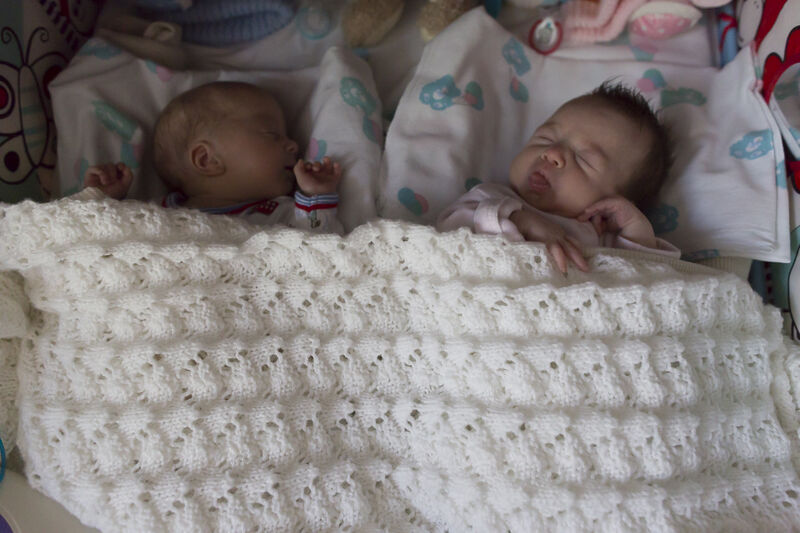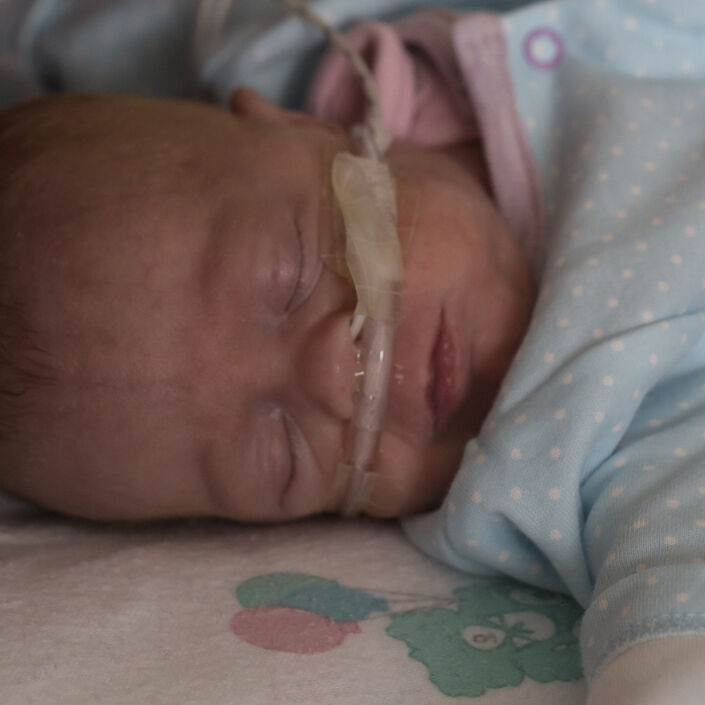Respiratory distress syndrome happens when babies’ lungs have not developed properly after birth. This is because their lungs do not have enough of a liquid called surfactant, so they cannot expand normally and provide enough oxygen. This causes babies to have problems with breathing after birth.
If doctors suspect that your baby will be born premature, they may offer steroid medication to reduce the risk of your baby developing RDS after they are born.
What causes RDS?
RDS happens more commonly in babies born premature (before 37 weeks of pregnancy). This is because babies born premature usually have lungs that are immature and have not developed fully.
This means that their lungs are likely to make less of a substance called surfactant. Surfactant is made up of proteins and fats and helps to keep the lungs inflated. If your baby’s lungs have low levels of surfactant, this can make the lungs still and unable to expand normally.
The earlier your baby is born, the more likely they are to have RDS.
Some babies who are born at term (after 37 weeks of pregnancy) are also at risk of RDS. Some risk factors include babies who are born:
If you are unsure about what might have caused your baby’s RDS, speak to a member of your baby’s healthcare team.
What are the signs of RDS?
Your baby is likely to be diagnosed with RDS on the neonatal unit. The signs of RDS usually appear in the first four hours after birth. These signs include:
- rapid or shallow breathing
- flaring of the nostrils
- noisy breathing or grunting
- blue skin or lips.
What tests might my baby have for RDS?
Your baby is likely to have one or more of the following tests:
Chest X-Ray
This is used to check your baby’s lungs. It can help to diagnose RDS.
Monitoring (including pulse oximetry, heart rate and breathing tests)
These are measured using sensors that are placed on your baby’s skin. Pulse oximetry measures how much oxygen is in your baby’s blood (also called blood oxygen saturation).
Blood gas test
This is a blood test which measures your baby’s levels of oxygen, carbon dioxide, and acid in the blood. Doctors will take blood from a heel prick sample. It can also be taken from a small plastic tube that is placed in your baby’s tummy button, hand or foot.
The treatment that your baby will need will depend on how early they are born and how severe their symptoms are. If you have questions or are unsure about any part of your baby’s treatment or care, speak to your baby’s healthcare team.
Treatment may include one or more of the following.
Surfactant therapy
Your baby may be given surfactant therapy to replace the low levels of surfactant in their lungs (see above). This is usually needed for a short time in the first two to three days after birth. This is because babies’ lungs will then start to produce their own surfactant.
Surfactant is usually given using an endotracheal tube, which is a plastic tube that is used to connect your baby to the ventilator. This tube goes through your baby’s mouth into their trachea (windpipe).
Surfactant can also be given through a thin tube that is passed into the trachea when your baby is on continuous positive airway pressure (CPAP). We have more information about CPAP below.
Oxygen therapy
Your baby may need some breathing support with oxygen therapy. Oxygen is usually given through a nasal cannula, which is a small soft tube that is put into your baby’s nose.
Some babies will be given high flow nasal cannula oxygen. This is where babies are given warmed oxygen through their nose at a high flow using a nasal cannula.
Continuous positive airway pressure (CPAP)
Continuous positive airway pressure (CPAP) is a type of respiratory (breathing) support. It passes air with or without oxygen (depending on what your baby needs) through two thin tubes in your baby’s nose, or through a small mask over their nose. CPAP slightly raises the pressure of the air, which helps to keep your baby’s lungs inflated.
During CPAP, your baby breathes on their own, but the machine helps to inflate the lungs in between breaths. When CPAP is used early, it reduces the risk of the baby needing mechanical ventilation.
Mechanical ventilation
Mechanical ventilators are used for babies who need more support with their breathing than other treatments can provide. There are two types of ventilator that are likely to be used:
- Conventional ventilators blow air with or without added oxygen (depending on what your baby needs) gently into your baby’s lungs. This happens through a tube which is passed through your baby’s nose or mouth and inflates your baby’s lungs.
- High frequency oscillating ventilators blow small amounts of air with or without added oxygen (depending on what your baby needs) into the lungs very quickly, hundreds of times a minute.
Medication
Doctors may give your baby medication for RDS. Some, such as caffeine citrate may be given to reduce the risk of your baby developing something called apnoea of prematurity (pauses in breathing) and chronic lung disease (CLD).
Some medications may be given to exclude other possible causes of your baby’s breathing problems.
Nutritional support
To ensure that your baby continues to grow and develop, they may be fed mother's own milk, formula or donor milk through a tube passed into your baby’s nose or mouth to their stomach. This is called tube feeding.
Some babies may also need to be fed using nutrition that is given in a liquid form directly into their bloodstream intravenously (into a vein). This is called parenteral nutrition (PN).
If your baby has RDS, you may have questions about how it will affect them in the short and long term.
In the short term, some babies with RDS can develop a pneumothorax, which happens when air leaks out of the lung. Asthma and Lung UK has some more information about pneumothorax in babies and children, including how it is treated and how long it can take to recover.
Some premature babies with RDS may later be diagnosed with chronic lung disease (CLD). In babies born premature, where their lungs are more immature, treatment for RDS can cause scarring and changes to the development and growth of the lungs. This can lead to CLD.
Doctors may suspect CLD in your baby if they need to remain on oxygen, CPAP or a ventilator when they are at 36 weeks gestation (corrected age), or after they are 28 days old. We have more information about CLD, treatment and long-term effects.



